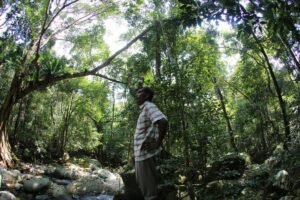
January 23, 2020; The Conversation
“A sharply divided panel of three federal judges on January 17th dismissed a high-profile climate lawsuit brought on behalf of 21 young people against the federal government,” write two Oregon law professors in the Conversation.
Both authors, Mary Wood at the University of Oregon and Michael Blumm at Lewis & Clark College, specialize in environmental justice law and were among more than 100 law professors who signed amicus briefs in support of the youth-led suit against the government for failing to take adequate action to protect children from the climate crisis.
As NPQ readers know, the federal court system moves slowly. Almost two years ago, NPQ’s Karen Kahn wrote about the so-called Climate Kids lawsuit, which bears the official name of Juliana v. United States. Originally, Kahn said, “the young people brought their suit against the Obama administration back in August 2015, but amended the suit in early 2017 to include President Trump as a defendant.”
The youth, who ranged in age from 8 to 19 years old at the time of the original filing, are represented by Our Children’s Trust, a nonprofit environmental advocacy group that is coordinating a global campaign to “secure the legal right to a healthy atmosphere and stable climate.”
A little over a year ago, NPQ’s Marian Conway also weighed in, citing named plaintiff Kelsey Juliana, now 23, who noted the government’s strategy throughout has centered on delay: “These defendants are treating this case, our democracy, and the security of mine and future generations like it’s a game. I’m tired of playing this game.”
The lawsuit’s claim is based on what is called public trust doctrine, which Wood and Blumm note is “a principle with ancient roots requiring government to hold and protect essential resources as a sustaining endowment for citizens, in the present and the future.” They add, “The young plaintiffs alleged a host of individual harms from climate disruption, including damage from fires, floods, sea level rise, and ocean warming that affects fisheries.”
The youth have had some legal victories along the way. In 2016, District Court of Oregon Judge Ann Aiken ruled that the plaintiffs had a constitutional right to a “climate system capable of sustaining human life.” As Wood and Blumm note, however, the Ninth Circuit Federal Court of Appeals’ ruling, while agreeing that the climate emergency posed a “clear and present danger” capable of destroying the nation, concluded it was not appropriate for the courts to intervene and that instead, it was up to Congress and the president to act—or not to act.
Sign up for our free newsletters
Subscribe to NPQ's newsletters to have our top stories delivered directly to your inbox.
By signing up, you agree to our privacy policy and terms of use, and to receive messages from NPQ and our partners.
It is pretty strange when the Court ruling against the young plaintiffs begins with the following paragraph:
In the mid-1960s, a popular song warned that we were “on the eve of destruction.” The plaintiffs in this case have presented compelling evidence that climate change has brought that eve nearer. A substantial evidentiary record documents that the federal government has long promoted fossil fuel use despite knowing that it can cause catastrophic climate change, and that failure to change existing policy may hasten an environmental apocalypse.
Nonetheless, the two judges in the majority, Andrew D. Hurwitz (who wrote the majority opinion) and Mary H. Murguia, end their opinion by writing, “We reluctantly conclude…that the plaintiffs’ case must be made to the political branches or to the electorate at large.”
In her dissent, Judge Josephine L. Staton countered, “It is as if an asteroid were barreling toward Earth and the government decided to shut down our only defenses. The government bluntly insists that it has the absolute and unreviewable power to destroy the Nation. My colleagues throw up their hands.”
Wood and Blumm acknowledge that achieving a reversal would be challenging. We know that plaintiffs’ attorneys intend to file what is known as an en banc petition, meaning they are seeking judicial review from the entire Ninth Circuit. If the appeal petition is granted by a majority of the circuit’s 29 judges, then “a panel of 11 judges will have an opportunity to reverse or affirm the panel’s decision to dismiss the case. The court allows this step, known as an en banc review, in very few cases.”
Additionally, Wood and Blumm note, “No matter what the outcome of the youths’ long-shot appeal to the full [ninth circuit] court, the losing party will likely seek review by the US Supreme Court.”
The odds of the “climate kids” prevailing is small, but not zero. Internationally, Wood and Blumm cite a precedent in their favor. Just last month, the Supreme Court of the Netherlands ordered a 25 percent reduction in emissions from 1990 levels by the end of 2020. In the Juliana case, plaintiffs are asking for a court-supervised federal plan, similar to how court-supervised school integration happened after Brown v. Board of Education in 1954, only this time to shrink the nation’s carbon footprint at a rate necessary to stave off disastrous levels of climate change.—Steve Dubb











